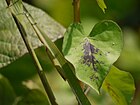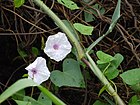Note: This is a project under development. The articles on this wiki are just being initiated and broadly incomplete. You can Help creating new pages.
Difference between revisions of "Ipomoea marginata - Laksmana"
(→Photo Gallery) |
(→External Links) |
||
| Line 97: | Line 97: | ||
[[Category:Herbs]] | [[Category:Herbs]] | ||
[[Category:Climber]] | [[Category:Climber]] | ||
| + | [[Category:Convolvulaceae]] | ||
Revision as of 12:23, 24 May 2019
Laksmanais a slender climber with heart shaped leaves and violet coloured flowers, closely related to morning glories. It has long been used in Kerala and is one of the ten sacred flowers of Kerala (Dasapushpa) it is found throughout India in the plains, especially on the bank of stream and rivers.
Contents
- 1 Uses
- 2 Parts Used
- 3 Chemical Composition
- 4 Common names
- 5 Properties
- 6 Habit
- 7 Identification
- 8 List of Ayurvedic medicine in which the herb is used
- 9 Where to get the saplings
- 10 Mode of Propagation
- 11 How to plant/cultivate
- 12 Commonly seen growing in areas
- 13 Photo Gallery
- 14 References
- 15 External Links
Uses
Parts Used
Chemical Composition
Common names
| Language | Common name |
|---|---|
| Kannada | thali keere soppu |
| Hindi | ban kalami |
| Malayalam | tiru-tali, tirutali |
| Tamil | |
| Telugu | metta thuti, tella thuti |
| Marathi | NA |
| Gujarathi | NA |
| Punjabi | NA |
| Kashmiri | NA |
| Sanskrit | laksmana, sitavalli, vrsaparnika |
| English |
Properties
Reference: Dravya - Substance, Rasa - Taste, Guna - Qualities, Veerya - Potency, Vipaka - Post-digesion effect, Karma - Pharmacological activity, Prabhava - Therepeutics.
Dravya
Rasa
Guna
Veerya
Vipaka
Karma
Prabhava
Habit
Identification
Leaf
| Kind | Shape | Feature |
|---|---|---|
| Simple | alternate | triangular-cordiform, 5-8 by 3-5 cm, apex acute-apiculate, base cordate, thinly pubescent, petiole 1-2 cm long. |
Flower
| Type | Size | Color and composition | Stamen | More information |
|---|---|---|---|---|
| Bisexual | Cyme | Pinkish white | Cymes sub-umbellate. Sepals sub-equal, obovate, glabrous. Corolla pinkish-white, c. 3 cm across, salver-form. Stamens included. |
Fruit
| Type | Size | Mass | Appearance | Seeds | More information |
|---|---|---|---|---|---|
| Capsule | Globose | Seeds pubescent | {{{6}}} |
Other features
List of Ayurvedic medicine in which the herb is used
Where to get the saplings
Mode of Propagation
How to plant/cultivate
Season to grow
Soil type
Propagation
Commonly seen growing in areas
Photo Gallery
References
External Links
Categories:
- Ayurvedic Herbs known to be helpful to treat Female sterility
- Herbs with Leaves used in medicine
- Herbs with common name in Kannada
- Herbs with common name in Hindi
- Herbs with common name in Malayalam
- Herbs with common name in Telugu
- Herbs with common name in Sanskrit
- Habit - Climber
- Index of Plants which can be propagated by Seeds
- Herbs that are commonly seen in the region of Tropical area
- Herbs
- Climber
- Convolvulaceae





